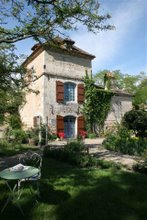
Cassoulet Recipe
Developed at "Camp Cassoulet"-- a Kate Hill French Kitchen Adventure.
This is the basic, bonafide, easy to prepare, authentic, traditional, real, regional version of cassoulet that I prepare, teach, cook and eat in my French Kitchen. The emphasize is on careful combining of very good ingredients, slow cooking and hearty enjoyment. I use duck confit and sausage de Toulouse, ventrèche ( salt cured pork belly), and pork rind for the meats. This is not gosple but pretty close. As much a state of mind as a recipe, this Cassoulet should feed your spirit as well as your belly. Invite a few friends- make it a party. That's what Camp Cassoulet is about.
This makes a large cassoulet that fills a 4-liter cassole and feeds 8 people easily.
Step 1: the beans
Ingredients:
- beans -1 kg dried beans (tarbais, coco, lingots, or other plump thin skinned white bean (for dried beans- soak several hours, over night or cover with water, bring to boil and let sit one hour.)
- 1 onion- peeled
- one whole carrot
- 2 cloves
- 2 garlic cloves
- Thick slice of ventrèche (pancetta), salt pork, bacon or ham ends.
- Ham bone or hock
- Fresh pork rind-(couenne) about a 4-by-12 inch strip or about 100gr, rolled and tied with a string
- Bouquet garni- bay, thyme and parsley stems.
- black peppercorns- a dozen slighty crushed
Step 2: the meat- prepare while the beans are cooking.
Ingredients:
- Duck- confit de canard- one/half leg per person (note: after slipping off most of the softened congealed fat from the surface of the duck legs, we trimmed any excess skin so as to leave just a covering to protect the meat. We jointed the thigh from the drumstick and then teased the thigh bone out resulting in a neat little package of confit meat that is easier to cut in the plate.)
- Saucisse de Toulouse- about 500 grams or about 15 cm/6 inches per person. This is a fresh pork sausage made from primarily the shoulder meat and seasoned with salt and pepper. Nothing else.
- Saucisse de Couenne- I love how these succulent sausages made with lean pork meat and the soft rind taste. They sort of explode with flavour in the cassoulet.
Step 3: to assemble the cassoulet
The traditional cassole bottom is just half of the diameter as the top, making a deep slant-sided glazed terracotta pot (see pictures). Remove the bouquet garni, ham bones, onion, carrot and rind from the beans. I chop the onion, carrot and rind into small bean-size pieces and take the tender meat off the ham bone then return all to the beans and gently stir in. USing a slotted spoon, the cassole is then layered with the beans, the confit and pieces of
Step 4- To cook the cassoulet
Slip the cassole into a very hot oven (around 450’ F/ 275’C); turn down the oven after 30 minutes to medium heat- 350' F/175'C and then let the cassoulet bake slowly as long as you can. The cassoulet in the electric oven is nicely browned in about 1-1/2 to 2 hours; ‘break’ the crust by pushing into down into the juices two or three more times. A wonderful crust forms during cooking so there is no need for a sprinkle of breadcrumbs* as the beans and starchy sauce do this by themselves. Cassoulets are not fatty and are nicely done in about 2 hours. If you start preparing the cassoulet at around 3 pm and you'll be sitting at the table by eight pm. This could be done in advance- all or in part by cooking the beans, and or assembling before baking.
Step 5: to serve
Pour a glass of hearty red wine like a Madiran, Cahors or Zinfandel, break the crust on top at the table, ladle the steaming cassoulet into dishes and prepare to be very full and very warm as stories are told around the kitchen table well into the night!







No comments:
Post a Comment